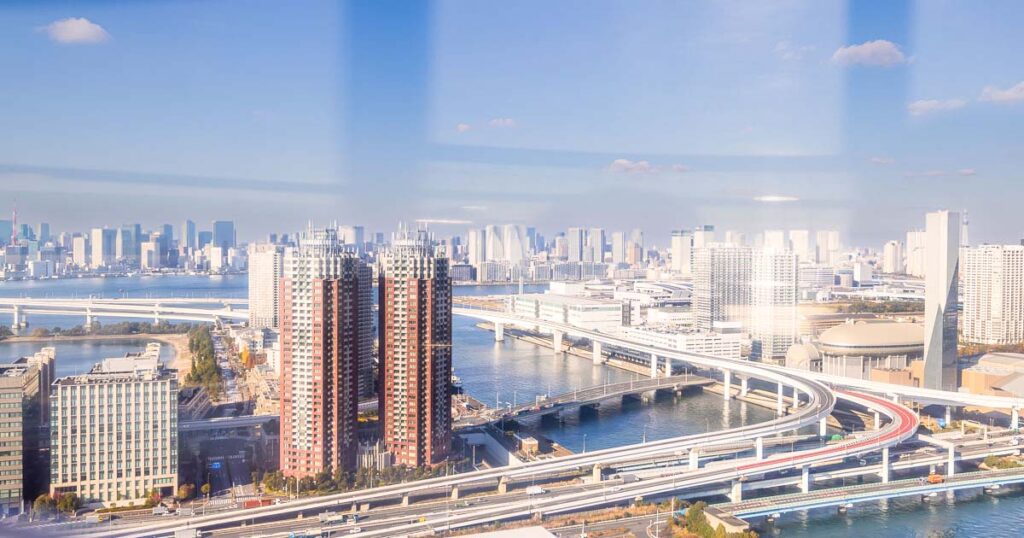Japan has always had a knack for enchanting visitors with its seamless fusion of traditional heritage and ultra-modern urbanism. The Odaiba rainbow bridge Tokyo is a fascinating marvel that stands as an icon of the city’s modern face. Known for its spectacular lighting displays and stunning panoramic views of Tokyo Bay, the Rainbow Bridge has attracted the hearts of locals and tourists alike, earning its place as one of Tokyo’s most famed landmarks.
Table of Contents
A Masterpiece of Engineering:
Constructed in 1993, the Rainbow Bridge is not just an architectural marvel but also a masterpiece of engineering. Spanning 798 meters and supported by two towering white towers, the bridge is a remarkable example of a suspension bridge, showcasing the incredible advancements in civil engineering of the period.
What sets this bridge apart from its contemporaries is its dual-deck design. The upper deck accommodates the Shuto Expressway’s Route 11, while the lower deck supports the Tokyo Metropolitan Expressway, the Yurikamome rapid transit line, and walkways on two sides, the north, and south. This multifunctional utility of the bridge reflects the efficiency of Japanese urban planning.
An Awe-Inspiring Spectrum of Lights:
The Rainbow Bridge wasn’t named after its architectural prowess but rather for its dazzling array of lights that bring the bridge to life at night. Every evening, hundreds of solar-powered lamps illuminate the bridge. The lights emit excellent illumination during winter, while the bridge glows warmly in the summer.
The natural spectacle, however, is on holidays and special occasions when the bridge is lit up in a multitude of colors reminiscent of a rainbow. This lighting spectacle contributes significantly to the bridge’s popularity, making it a symbolic part of Tokyo’s nighttime skyline.
Stunning Panoramic Views:
The pedestrian walkways on the rainbow bridge Tokyo offer an unparalleled vista of Tokyo Bay. From this vantage point, viewers can witness a myriad of Tokyo’s landmarks, including the Tokyo Tower, Skytree, and even the majestic Mt. Fuji on a clear day. In addition, this stunning view provides an incredible backdrop for photos, making it a beloved spot for both professional photographers and selfie enthusiasts.
An Access to Odaiba:
Odaiba in Japan is a large artificial island in Tokyo Bay known for its futuristic architecture, entertainment complexes, and shopping districts. The Rainbow Bridge serves as the main access point to this popular tourist hub, connecting the island to the rest of Tokyo. This pivotal role makes the Rainbow Bridge a symbol of the bustling metropolis.
In Conclusion:
The Rainbow Bridge is a perfect reflection of Tokyo’s spirit – it’s a symbol of the city’s constant evolution, combining utility, aesthetics, and sustainability. It embodies Tokyo’s urban vibrancy and technological prowess while offering a magical spectacle of lights and unparalleled views of the city. Its unique attributes and role in connecting Odaiba to mainland Tokyo have contributed to its fame, making it an essential visit for anyone traveling to Tokyo.
So next time you’re in Tokyo, witness the dazzling lights of the rainbow bridge Tokyo and indulge in the breathtaking panorama of the cityscape. The Rainbow Bridge isn’t just a means to cross Tokyo Bay – it’s a journey of sights and experiences that one shouldn’t miss.
How to access it?
To access Rainbow Bridge Tokyo, you have several options:
1. By Car:
Take the Metropolitan Expressway and exit at Rainbow Bridge or Shibaura. Note that tolls apply.
2. By Train:
Take the Yurikamome Line to Odaiba or Shimbashi Station. Visitors can walk or take a shuttle bus to Rainbow Bridge.
3. By Bus:
Many bus routes connect to Rainbow Bridge. Check with local bus operators for specific routes and schedules.
4. On foot:
To access Rainbow Bridge Tokyo on foot, you can use the pedestrian walkway located on the lower deck. It is accessible from Odaiba or Shimbashi stations.
Pedestrian access is limited to specific hours:
- April to September: from 9:00-21:00 and
- October to March: from 10:00-18:00
Note: It’s always better to check for any updates or restrictions before your visit, as access to Rainbow Bridge may be subject to change due to maintenance or special events.
